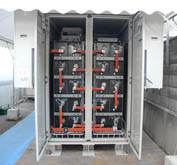Test Succeeds in Reusing Regenerative Energy of Railway Storage Battery System
Dec. 17, 2007

|
Tokyo, December 17, 2007 – Kawasaki Heavy Industries, Ltd. announced today that it has successfully completed a verification test on the reuse of energy from regenerating braking, using a land storage battery system with the Gigacell®, its proprietary nickel metal-hydride battery. The Gigacell-driven system was tested at substations of the Osaka subway, with the cooperation of the Osaka Municipal Transportation Bureau and Kotsu Service Co., Ltd., Kawasaki verified that energy generated by a train’s braking could be stored and reused to compensate for the voltage fall-offs that occur during startup, operation and congested rush hours. This advance is expected to contribute to energy savings and a reduction in the environmental burden of train lines, as it will prevent a syndrome called “regeneration cancellation.” It will thus allow the entire railway system to operate on less energy, reducing the contracted electricity volumes with power companies and lowering the costs associated with opening new substations. Kawasaki also conducted tests on emergency operations during power outages and confirmed that the battery system enabled trains to reach the nearest station at a lower speed without compromising on air conditioning or lighting. The battery system for railways was developed by Kawasaki using the Gigacell, which is tailored to large-scale applications, with quick charge/discharge capabilities. These features allow Gigacell to be connected to overhead lines directly without a control system and minimize the power loss during charging/discharging. Because it is only 5.4 m3 in volume, four units can be installed in parallel in substations. For enhanced safety in case of emergencies, the battery system is also equipped with high-speed DC circuit breakers on both the negative and positive terminals to disconnect the system from overhead lines and prevent short-circuiting. |





